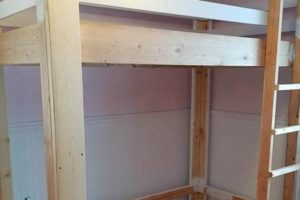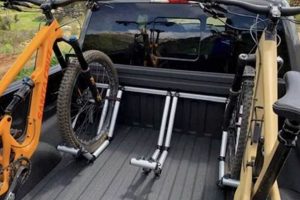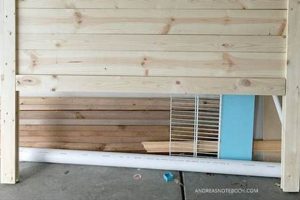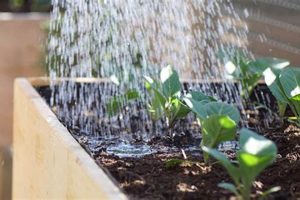The process of creating and implementing a self-constructed watering system for elevated planting containers constitutes a specific approach to horticulture. These systems provide a tailored solution for delivering water directly to the root zone of plants grown in above-ground beds. An example includes utilizing soaker hoses connected to a timer-regulated water source within a framed garden structure.
Implementing such a system is significant due to its potential to conserve water, reduce manual labor, and promote consistent plant growth. Historically, innovative gardeners have sought methods to optimize resource use and improve crop yields. Automated watering represents a modern extension of these efforts, addressing water scarcity and labor constraints within a manageable framework.
Subsequent sections will detail the necessary components, design considerations, construction techniques, and maintenance procedures for effective automated watering in elevated garden settings. Information on water pressure regulation, timer selection, and emitter placement will also be provided to ensure optimal system performance.
Essential Considerations for Automated Elevated Garden Watering Systems
The following recommendations are provided to optimize the design and functionality of automated watering setups in raised garden beds.
Tip 1: Water Source Evaluation: Prior to system installation, assess the available water pressure and flow rate. Insufficient pressure may necessitate a pressure booster, while excessive pressure could damage system components. A pressure regulator is recommended.
Tip 2: Drip Emitter Selection: Choose drip emitters appropriate for the specific plant’s water requirements and soil type. Consider pressure-compensating emitters for uniform water distribution, particularly in sloped or uneven beds.
Tip 3: Timer Programming: Program the irrigation timer to deliver water during the early morning hours to minimize evaporation and maximize water absorption by plants. Adjust watering schedules based on seasonal variations and weather patterns.
Tip 4: Filtration Implementation: Incorporate a filter into the system to prevent debris from clogging emitters. Regularly clean or replace the filter element to maintain optimal system performance.
Tip 5: Tubing Material Selection: Select UV-resistant tubing to prevent degradation from sunlight exposure. Black polyethylene tubing is a durable and cost-effective option.
Tip 6: System Layout Planning: Design the irrigation system layout to ensure complete and uniform coverage of the root zone. Avoid overlapping water patterns, which can lead to water wastage and disease development.
Tip 7: Winterization Procedures: In regions with freezing temperatures, winterize the automated watering system by draining all water from the lines and storing sensitive components, such as timers, indoors. This prevents damage from freezing and expanding water.
Adhering to these guidelines can significantly enhance the efficiency and longevity of automated watering in elevated planting beds, promoting healthy plant growth and water conservation.
The next section will address common issues and troubleshooting techniques related to these irrigation systems.
1. System Design
System design constitutes the foundational element in the successful implementation of a self-constructed watering apparatus for elevated garden beds. A comprehensive design ensures efficient water distribution, minimizes water wastage, and promotes optimal plant health.
- Water Source Analysis and Planning
Determining the water source’s pressure and flow rate is critical. Insufficient pressure necessitates a booster pump, while excessive pressure requires a regulator to prevent component damage. Planning involves mapping the water source location relative to the raised beds to minimize tubing length and potential pressure drops.
- Emitter Selection and Placement Strategy
The selection of emittersdrip emitters, micro-sprinklers, or soaker hosesdepends on plant type, spacing, and water requirements. Precise placement of emitters near the root zone ensures direct water delivery, reducing evaporation and weed growth. A well-designed system considers the specific needs of each plant within the raised bed.
- Layout Optimization and Zonal Irrigation
Optimizing the system layout involves arranging tubing and emitters to provide uniform water coverage across the entire raised bed area. Implementing zonal irrigation, dividing the bed into sections with different watering needs, allows for customized watering schedules and prevents overwatering or underwatering specific plant groups. This maximizes water efficiency and plant health.
- Automation Integration and Control Mechanisms
Integrating automation, such as timers and soil moisture sensors, into the system design enhances its efficiency and convenience. Timers allow for scheduled watering, while soil moisture sensors adjust watering based on real-time soil conditions, preventing overwatering and conserving water. A comprehensive design considers the integration of these control mechanisms for optimal system performance.
The integration of these facets into the overall system design directly impacts the efficiency and effectiveness of elevated garden bed watering. A well-designed system not only saves water but also promotes healthier plant growth and reduces the labor involved in manual watering.
2. Component Selection
Effective implementation of self-constructed watering systems for elevated garden beds is intrinsically linked to the careful selection of system components. Component selection dictates the functionality, efficiency, and longevity of the irrigation apparatus. Inadequate or inappropriate components compromise water distribution uniformity, increase the risk of system failures, and ultimately diminish plant health and resource utilization. For example, utilizing low-quality tubing susceptible to UV degradation leads to leaks and pressure loss, negating the benefits of a well-designed irrigation schedule. Similarly, mismatched fittings or emitters can create uneven water distribution, resulting in some plants receiving insufficient water while others are overwatered.
The selection process must consider factors such as water source pressure, plant-specific water requirements, and the physical dimensions of the raised garden bed. Drip emitters, soaker hoses, and micro-sprinklers each offer distinct advantages and disadvantages, influencing the overall system performance. Drip emitters, for instance, provide targeted water delivery, minimizing water wastage through evaporation. Soaker hoses offer a broader distribution pattern, suitable for densely planted areas. Micro-sprinklers provide a wider coverage area, but may not be appropriate for drought-sensitive plants. Moreover, the selection of timers and controllers should align with the user’s technical proficiency and the desired level of automation. A basic timer offers simple scheduling, while advanced controllers allow for integration with soil moisture sensors and weather data for dynamic irrigation adjustments.
In summary, component selection constitutes a critical determinant in the success of automated elevated garden bed watering. A thorough assessment of system requirements, combined with an understanding of the characteristics of various components, is essential. While a less-than-perfect design may still function adequately with superior components, even the most sophisticated design will fail to deliver desired results if the constituent parts are ill-suited for the application.
3. Water Regulation
Water regulation is a critical aspect of self-constructed watering systems for elevated garden beds. Precise management of water pressure and volume is essential for efficient resource utilization and optimal plant health. Unregulated water delivery can lead to water wastage, nutrient leaching, and plant stress.
- Pressure Management in Drip Systems
In drip irrigation, maintaining consistent water pressure is vital. Excessive pressure can cause emitters to malfunction or detach, leading to leaks and uneven water distribution. Conversely, insufficient pressure results in inadequate water delivery. Pressure regulators are crucial components, ensuring a stable pressure range irrespective of fluctuations in the main water supply. For example, a regulator installed upstream of the drip system can maintain a consistent 25 PSI, irrespective of whether the incoming pressure fluctuates between 40 and 60 PSI.
- Timer-Based Irrigation Scheduling
Irrigation timers enable precise control over the duration and frequency of watering events. Pre-programmed schedules can be tailored to specific plant water requirements and seasonal variations. Advanced timers integrate weather data and soil moisture sensors to adjust watering schedules dynamically. For instance, a timer set to deliver water for 15 minutes every morning can be automatically adjusted to 10 minutes on rainy days, preventing overwatering.
- Flow Control and Zone Management
Dividing raised beds into zones with varying plant water needs necessitates flow control mechanisms. Ball valves or zone controllers allow gardeners to regulate water flow to specific sections of the bed. For example, a zone with drought-tolerant herbs can receive less water than a zone with water-intensive vegetables. This targeted approach minimizes water wastage and optimizes resource allocation.
- Backflow Prevention Measures
To protect the potable water supply, backflow prevention devices are essential. These devices prevent irrigation water, which may contain fertilizers and pesticides, from flowing back into the main water line. A simple check valve or a more sophisticated reduced pressure principle backflow preventer ensures the safety of the water supply, complying with local regulations and preventing contamination.
In conclusion, effective water regulation in elevated garden bed watering systems requires a multi-faceted approach encompassing pressure management, scheduled irrigation, flow control, and backflow prevention. Integration of these components ensures efficient water utilization, promotes plant health, and safeguards the potable water supply.
4. Installation Technique
The proper installation of a self-constructed watering system is paramount to its efficiency and longevity within the context of elevated garden beds. The selection of high-quality components and a meticulously planned design are rendered ineffective by substandard installation practices. Attention to detail during installation directly influences water distribution uniformity, system reliability, and overall horticultural outcomes.
- Tubing Connection Integrity
Secure and leak-proof connections between tubing sections and system components are essential. The use of appropriate fittings, such as barbed connectors and compression fittings, is critical. Improperly secured connections result in water loss, pressure reduction, and potential system failure. For instance, failing to adequately tighten a compression fitting on the main supply line leads to a slow leak, gradually reducing water pressure available to the emitters further down the line. This results in uneven watering and compromised plant growth.
- Emitter Placement and Stabilization
Precise placement of emitters near the root zone of plants ensures efficient water delivery. Stabilization of emitters prevents displacement due to wind, foot traffic, or soil movement. Employing stakes or securing emitters with landscape staples maintains their position, directing water precisely where needed. Without proper stabilization, an emitter might shift, watering only the surrounding soil and depriving the intended plant of adequate moisture.
- Depth and Protection of Buried Tubing
When burying sections of the irrigation system’s tubing, adhering to appropriate depth guidelines protects the lines from damage. Burying tubing too shallowly exposes it to potential impact from gardening tools or compaction from foot traffic. Conversely, excessively deep burial makes access for repairs difficult. A recommended burial depth of 4-6 inches provides sufficient protection while allowing for relatively easy access. Furthermore, encasing tubing in protective sleeves or gravel beds mitigates damage from rocks or sharp objects.
- Slope Considerations and Drainage Provisions
When installing irrigation systems on sloped terrain, accounting for elevation changes is crucial. Water pressure increases at lower elevations and decreases at higher elevations. Incorporating pressure regulators at strategic points along the system compensates for these variations. Additionally, providing drainage points at the lowest elevations prevents water accumulation, which can lead to waterlogging and root rot.
Therefore, the success of a self-constructed watering system for elevated garden beds hinges not only on design and component selection but also on the meticulous execution of installation techniques. Adherence to proper procedures ensures efficient water delivery, minimizes water wastage, and promotes sustained plant health. A poorly installed system negates the benefits of even the most sophisticated design, emphasizing the importance of skilled and careful installation practices.
5. Maintenance Schedule
A structured maintenance schedule constitutes a critical component of any successful “diy raised garden bed irrigation” system. The absence of routine maintenance directly precipitates decreased system efficiency, increased water wastage, and potential system failure. The cause-and-effect relationship is demonstrably clear: neglected maintenance results in compromised performance, whereas consistent maintenance ensures sustained functionality. For instance, a failure to regularly flush drip lines leads to mineral buildup and emitter clogging, reducing water flow and creating uneven moisture distribution. This, in turn, stresses plants, diminishes yields, and potentially increases susceptibility to disease.
The practical significance of integrating a rigorous maintenance schedule into irrigation management lies in its ability to prevent costly repairs and extend the lifespan of the system. Regularly inspecting tubing for leaks or damage allows for timely repairs, preventing significant water loss and soil erosion. Cleaning or replacing filters prevents clogging, ensuring optimal water pressure and consistent flow rates. Adjusting emitter placement as plants mature ensures that water is delivered directly to the root zone, maximizing water use efficiency. Furthermore, winterizing the system in regions with freezing temperatures, such as draining water lines and protecting sensitive components, prevents damage from ice expansion and contraction, saving the cost of replacing damaged parts.
In summary, a well-defined maintenance schedule is not merely an ancillary aspect of “diy raised garden bed irrigation” but an integral element that directly affects its performance, efficiency, and longevity. Overlooking this essential component inevitably leads to reduced system effectiveness and increased operational costs. Embracing a proactive approach to maintenance ensures the continued health of plants, conservation of water resources, and prolonged lifespan of the irrigation investment.
Frequently Asked Questions
The following addresses common inquiries related to the design, implementation, and maintenance of self-constructed watering systems for elevated planting beds. Information provided aims to clarify best practices and optimize system performance.
Question 1: What is the optimal water pressure for a drip irrigation system in a raised garden bed?
The optimal water pressure typically ranges from 15 to 30 PSI. Exceeding this range may damage system components, while insufficient pressure results in inadequate water delivery. Pressure regulators are essential for maintaining consistent pressure, irrespective of fluctuations in the main water supply.
Question 2: How frequently should a self-constructed watering system be inspected for leaks or clogs?
A visual inspection should be conducted at least weekly. More frequent inspections are advisable during periods of peak water usage or after significant weather events. Addressing leaks and clogs promptly prevents water wastage and ensures uniform water distribution.
Question 3: What type of filtration is recommended for preventing emitter clogging in a raised garden bed irrigation system?
A 150-200 mesh filter is generally recommended for removing particulate matter that can clog emitters. The filter should be cleaned or replaced regularly, depending on the water quality and usage frequency.
Question 4: How should the watering schedule be adjusted based on different plant types within a single raised garden bed?
Zonal irrigation is recommended, dividing the raised bed into sections with differing water requirements. Individual zones can then be watered according to the specific needs of the plants within that zone, using separate valves or adjustable emitters.
Question 5: What steps should be taken to winterize a DIY raised garden bed irrigation system in a region with freezing temperatures?
All water must be drained from the system, including tubing, emitters, and backflow preventers. Sensitive components, such as timers and controllers, should be removed and stored indoors to prevent damage from freezing temperatures.
Question 6: Is it necessary to use a backflow preventer in a DIY raised garden bed irrigation system, and if so, what type is recommended?
A backflow preventer is essential for protecting the potable water supply from contamination. A simple check valve is often sufficient for residential systems, but local regulations may require a more sophisticated reduced pressure principle backflow preventer.
Adhering to these guidelines will enhance the efficiency, longevity, and safety of self-constructed watering setups in elevated planting beds, promoting healthy plant growth and responsible water usage.
The next section will delve into advanced techniques for optimizing water usage in raised garden bed irrigation systems.
Conclusion
The preceding discussion has systematically explored the design, implementation, maintenance, and optimization of “diy raised garden bed irrigation” systems. Crucial elements encompass meticulous system design, careful component selection, effective water regulation, precise installation techniques, and diligent maintenance practices. Adherence to these principles dictates the overall efficiency, longevity, and effectiveness of the irrigation apparatus.
Recognizing the significance of informed decision-making in resource management, practitioners are encouraged to utilize the information presented to cultivate sustainable and productive elevated garden environments. Further refinement of “diy raised garden bed irrigation” techniques will undoubtedly contribute to advancements in water conservation and horticultural practices.







